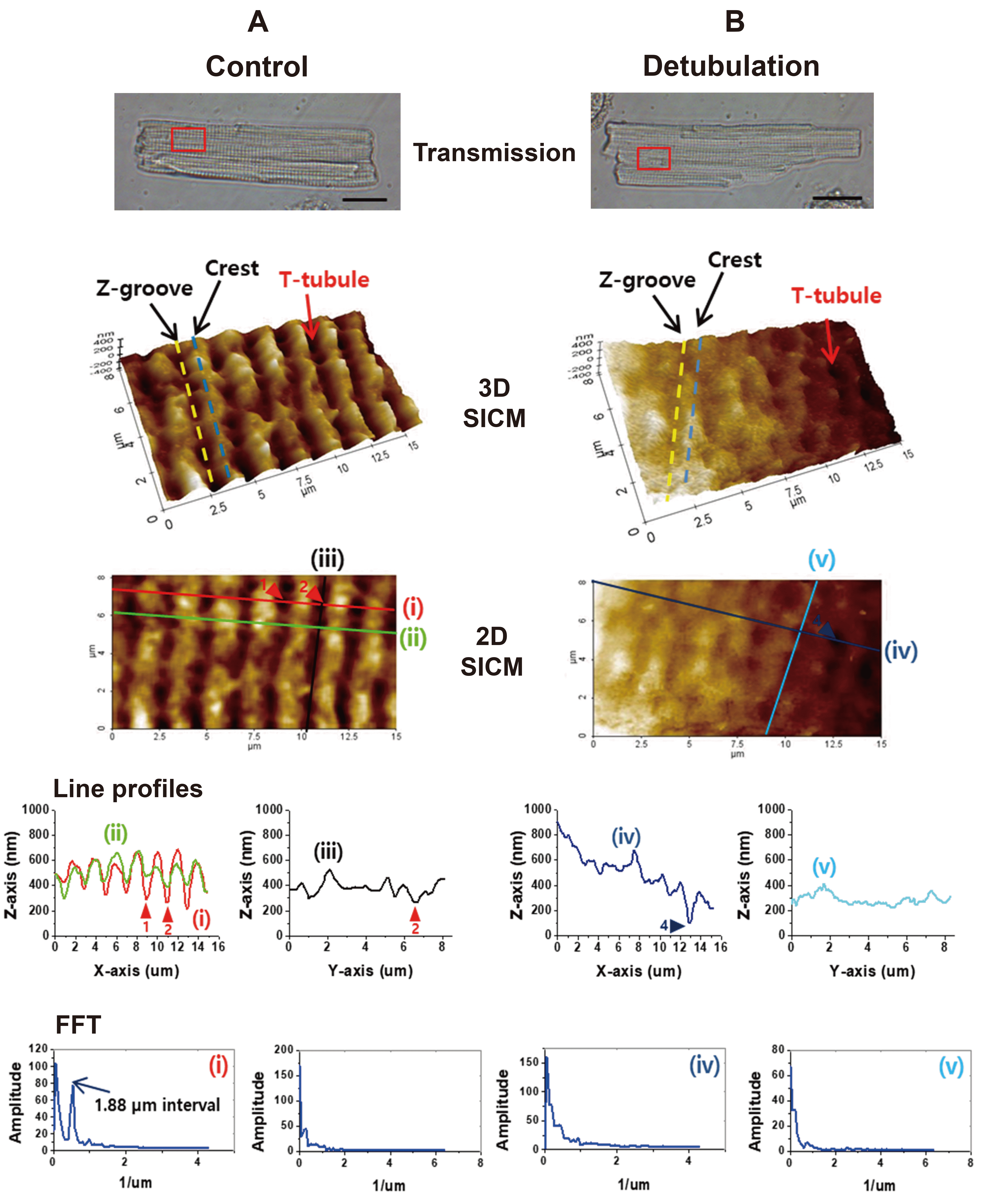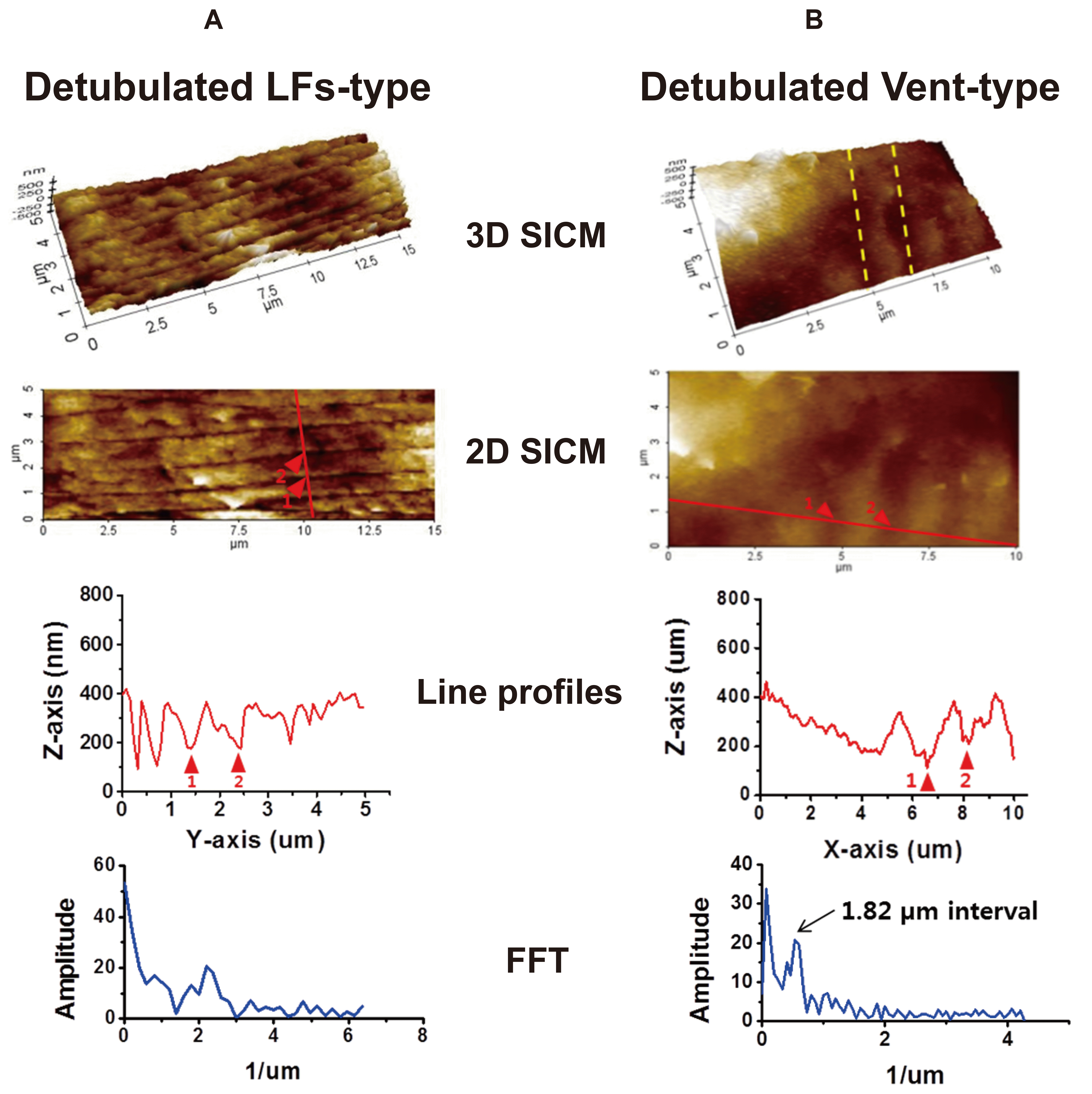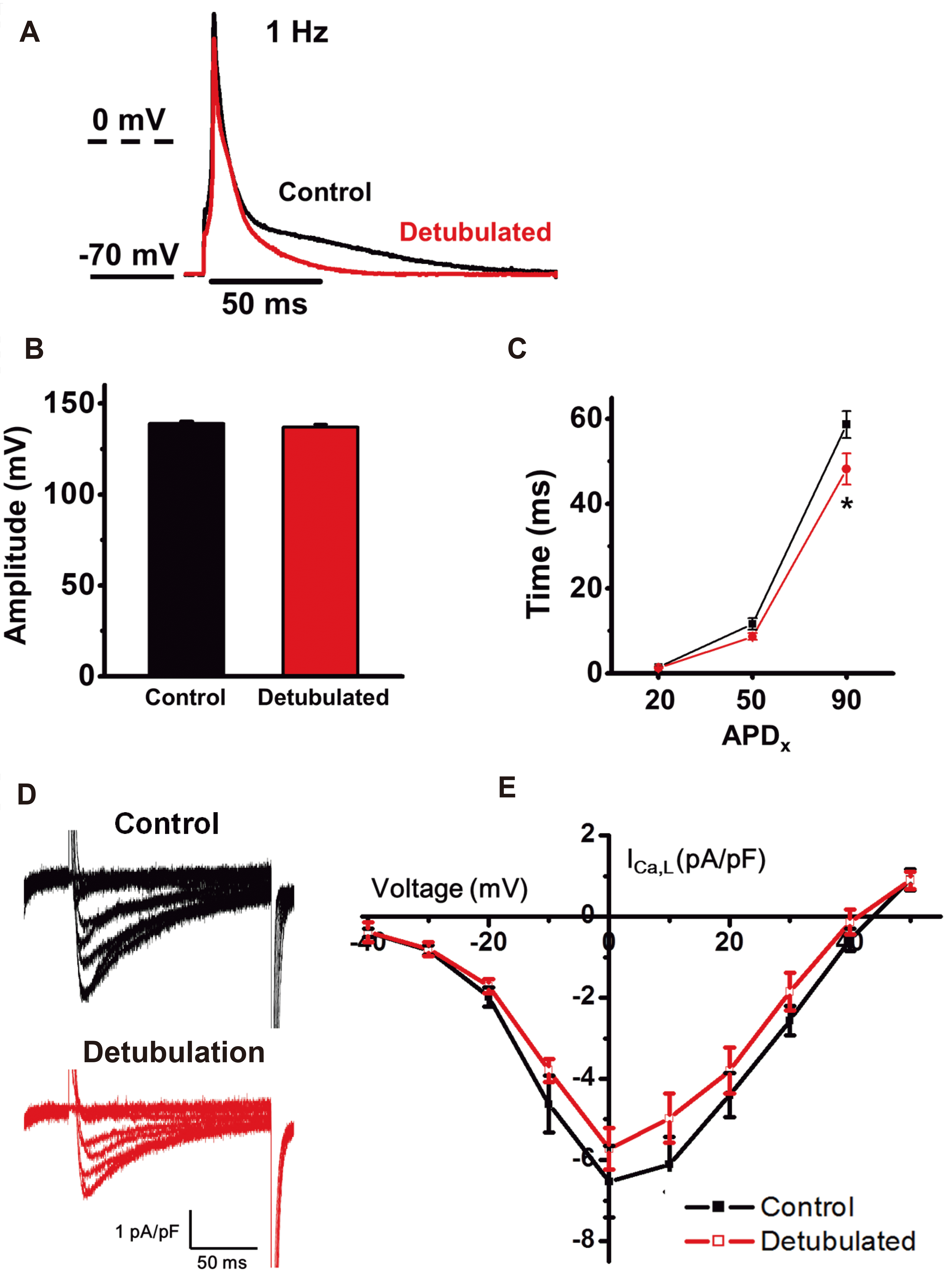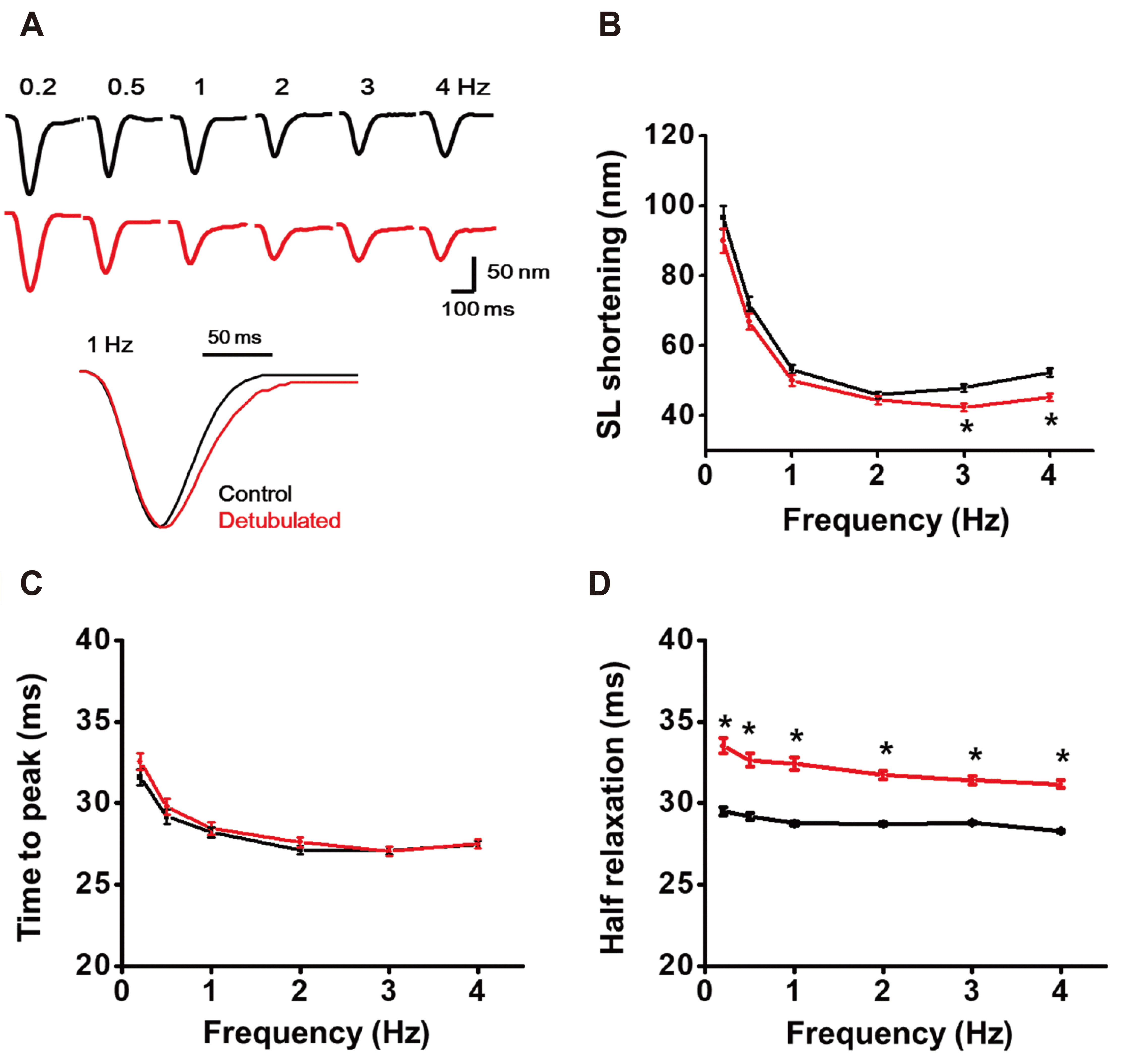INTRODUCTION
The transverse tubules (T-tubules) of the cardiomyocytes are perpendicular invaginations of the plasma membrane that regularly positioned on the Z-lines. As the T-tubule membranes contain multiple ion channels and transporters, such as L-type Ca
2+ channel (LTCC) and Na
+/Ca
2+ exchanger (NCX), the abundance and organization of T-tubules determine action potential duration (APD) and consequent Ca
2+ signaling patterns. Therefore, T-tubule is a key structural element for efficient cardiac excitation-contraction coupling (EC-coupling). Ventricular cardiomyocytes have well-organized T-tubules that convey sarcolemmal action potential (AP) throughout the cell interior and produce global Ca
2+ transient and muscle contraction [
1]. At the junctions of the T-tubule membrane and the sarcoplasmic reticulum (SR) membrane, functional coupling between LTCC and ryanodine receptor Ca
2+ release channels (RyRs) produces synchronized Ca
2+-induced Ca
2+ release that causes myofilament contraction [
2]. Also, this spatial coupling between the T-tubule and the SR is critical for diastolic Ca
2+ extrusion. The higher expression of NCX on the T-tubule membrane and abundant expression of SR Ca
2+-ATPase (SERCA) close to the T-tubules support efficient Ca
2+ extrusion and sequestration during diastole [
3]. As a consequence, not only the degree of T-tubule development but also its structural integrity determines the spatiotemporal synchronization of Ca
2+ transient that gives efficient EC-coupling. It is quite noteworthy that disrupted T-tubules were often found in diseased hearts such as heart failure, cardiac hypertrophy, and ischemic heart disease [
4-
6].
It has long been thought that atrial myocyte lacked the T-tubule system. As a consequence, the absence of T-tubules does not guarantee a rapid and homogenous intracellular Ca
2+ transient that produces a sub-maximal systolic force. Therefore, atrial EC-coupling and related Ca
2+ signaling have often been explained by the mechanism of centripetal Ca
2+ wave [
7]. In atrial myocytes with no T-tubule system, a systolic Ca
2+ transient that initiates at the cell periphery propagates toward the deep area of the myocyte as a centripetal Ca
2+ wave [
7-
9]. However, recent investigations have suggested that atrial myocytes preserve some T-tubules with a great diversity in morphology and abundance [
10]. It is suggested that the larger the animals, the higher the T-tubule expression. Relatively well-organized T-tubules were found in humans or sheep atria, but rudimentary T-tubules were observed in the atria of small laboratory animals such as rats and mice [
11,
12]. Therefore, it is difficult to estimate accurately the contribution of T-tubules on atrial EC-coupling because of its sparsity, structural diversity, cell to cell variation, and interspecies difference. Furthermore, it is quite difficult to evaluate the pathological consequences of partially destroyed T-tubules in diseased atria.
Confocal microscopic imaging of the living cardiomyocytes stained with lipophilic membrane dye (di-8-ANEPPS) has been widely used to visualize intracellularly oriented T-tubule network [
13,
14]. Additional immunostaining of the fixed cells against T-tubule specific proteins (caveolin-3 or dihydropyridine receptors) revealed further the 3-dimensional distribution of intracellular T-tubules [
14]. Although these classical T-tubule staining techniques are advantageous for visualization of the internal architecture of the T-tubule network [
5], it cannot reveal nanometers-sized T-tubule openings or orifices on the cell surface, especially in living cardiomyocytes. When the T-tubules are stained in ventricular myocytes it is relatively easy to figure out the surface T-tubule openings, because ventricular T-tubules invaginate perpendicular to the surface membrane and striated at a regular interval along the Z-lines. However, visualization of the surface T-tubule openings from atrial myocytes is very difficult because of the rudimentary, heterogeneous, and amorphous architecture of the T-tubule system.
Therefore, the present study aimed to visualize the cell surface T-tubule openings at a nanometer resolution scale in isolated living atrial myocytes. To the purpose we used a newly developed nanoimaging technique, scanning ion conductance microscopy (SICM), which is a modified scanning probe microscopy (SPM) technique [
15]. In general, SPM is a microscopic imaging technique that scans a probing tip over a sample surface to give the physical profiles of the sample at a nanometer-scale resolution. Although various SPM technologies including atomic force microscopy have been developed, there are many difficulties with its application to the live cells in physiological conditions [
16,
17]. SICM is a modified SPM technique that permits noninvasive topographical imaging of live cell membrane at several tens of nanometers resolution [
15]. As a scanning probe, SICM uses a vertically positioned glass nanopipette with a tip diameter of < 100 nm that filled with conducting salt solutions [
18].
By SICM imaging of the atrial cell surface, confocal imaging of the di-8-ANEPPS stained intracellular T-tubules, patch-clamp electrophysiology, and myocyte contraction measurement, we aimed to understand (i) the structural features of surface T-tubule openings and membrane nanostructures, (ii) the architecture of intracellular T-tubule network, (iii) relationship between the T-tubule network and surface structure, and (iv) the consequences of detubulation on the T-tubules and EC-coupling of the rat atrial myocytes.
Go to :

METHODS
Isolation of rat cardiomyocytes
The use of animals and all procedures were approved by the Institutional Animal Care and Use Committee (IACUC) at Sungkyunkwan University, Korea (approval No. SKKUIACUC2018-04-08-3). Cardiomyocytes were isolated from male Sprague–Dawley (SD) rats of 8–10 weeks old. The rats were anesthetized in a CO2 chamber and then sacrificed by cervical dislocation. The heart was quickly removed and mounted on a Langendorff perfusion apparatus. To keep the heartbeat and clear the coronary circulation, retrograde perfusion was processed at 37°C with a Ca2+-containing Tyrode solution containing (in mM) 141.4 NaCl, 4 KCl, 0.33 NaH2PO4, 5.5 glucose, 1.8 CaCl2, 1 MgCl2, 14.5 D-mannitol, 10 HEPES, pH adjusted at 7.4 with NaOH. Then, the heart was perfused further for 6 min with Ca2+-free Tyrode solution containing (in mM) 135 NaCl, 5.4 KCl, 5 HEPES, 0.4 Na2HPO4·12H2O, 20 taurine, 3.5 MgCl2, 5 glucose, pH adjusted at 7.4 with NaOH. After that, the heart was perfused with a Ca2+-free digestion solution containing collagenase type II (Worthington, Lakewood, CA, USA) 1 mg/ml, protease (Sigma-Aldrich, St. Louis, MO, USA) 1 mg/ml, 0.2% bovine serum albumin (BSA; Sigma-Aldrich), CaCl2 0.05 mM for 8 min at 37°C. Both atria were carefully excised from the heart, chopped, and gently shaken at 37°C in a solution containing collagenase type II (Worthington) 1 mg/ml, 0.2% BSA, CaCl2 0.05 mM. Isolated myocytes were washed by 1% BSA and kept in Ca2+-free storage solution containing (in mM) 120 NaCl, 5.4 KCl, 5 MgSO4·7H2O, 5 sodium pyruvate, 5.5 glucose, 20 taurine, 10 HEPES, 29 D-mannitol, pH 7.4 with NaOH. The same digestion protocol was used for the isolation of ventricular myocytes. The cardiomyocytes were used for experiments within 6 h of the isolation.
Scanning ion conductance microscopy
We used a SICM device (XE-Bio; Park Systems, Suwon, Korea) consisted of a glass nanopipette, an X–Y scanner, a Z-axis piezo driver, a current amplifier, a feedback controller, an inverted microscope, and a data acquisition system. Isolated cardiomyocytes were placed in a 35-mm culture dish containing Ca
2+-free storage solution, and SICM imaging was conducted at room temperature (~25°C). Imaging of the cell surface was operated under the ARS-mode (Park Systems) or hopping-mode of SICM [
19,
20]. The probing nanopipette was fabricated with 1.0 mm outer diameter and 0.58 mm inner diameter borosilicate glass tubing (Warner Instrument, Hamden, CT, USA) using a laser puller P-2000 (Sutter Instrument, Novato, CA, USA). In all experiments, measured nanopipette resistance was ~150 MΩ when it was filled with a Ca
2+-free cell storage solution. The scan size was measured differently for each cell with a randomly selected area. The scanning pixel was 128 (X-axis) by 128 (Y-axis). The cells were imaged with the XEP software program (ver. 1.7.94 build 9; Parks Systems), and the acquired topographic images were analyzed with the XEI analysis program (ver. 1.8.0 build 20; Park Systems).
Confocal imaging of the intracellular T-tubules with di-8-ANEPPS staining
The cardiomyocytes were incubated with 5 µM di-8-ANEPPS, a membrane fluorescent dye (Sigma-Aldrich), for 5 min at room temperature and immediately washed twice with cell storage solution. All image acquisition was completed on confocal laser microscopy (Zeiss LSM-710; Zeiss, Oberkochen, Germany) by using 488 nm excitation light with detection at > 505 nm. Z-stack images were recorded with the same X–Y pixel (1024 by 1024) size and a z-step of 0.5 µm intervals.
Formamide-induced detubulation protocol
For detubulation (an acute removal of T-tubules), the cardiomyocytes were bathed in a control bath solution containing (in mM) 113 NaCl, 5 KCl, 1 MgSO
2, 1 CaCl
2, 1 Na
2HPO
4, 20 sodium acetate, 10 glucose, 5 U/L insulin, pH 7.4 with NaOH. Then, the myocytes were treated with 1.5 M of formamide (Sigma-Aldrich) for 15 min at room temperature and washed with a control bath solution to induce detubulation [
21].
Analysis of the line profiles with Fast Fourier transformation (FFT)
The line profiles obtained from the SICM images and confocal images were analyzed with a FFT algorithm to retrieve regular organization or positioning of the T-tubules or Z-grooves. The power spectrum of the desired line profile was extracted from 2D topographic SICM images by the XEI analysis program (Park Systems). The line profiles and power spectrums of the confocal images were analyzed with the Zen 2011 program (Zeiss). From the retrieved power spectrum peaks, we determined the regularly repeating appearance of T-tubules or Z-grooves. The FFT analysis was used to evaluate the presence of T-tubules and its remodeling before and after the formamide-induced detubulation protocol [
5].
Whole-cell patch-clamp recording
Cell membrane capacitance (Cm) and LTCC were recorded by conventional whole-cell patch-clamp configuration, and APs were measured by nystatin (0.2 mg/ml, dissolved in DMSO; Glentham, Edinburgh, UK)-perforated configuration at RT. Atrial myocytes were placed on a recording chamber mounted on an inverted microscope (IX-70; Olympus, Tokyo, Japan). Patch pipettes were pulled from borosilicate glass tubing (#1B150F-4; WPI, Sarasota, FL, USA) with a vertical puller (PP-830, Narashige, Tokyo, Japan) to give 2–3 MΩ tip resistance when filled with internal pipette solutions. Pipette capacitance and series resistance were compensated up to > 70%. Cell membrane capacitance was measured by integrating the capacitance current activated by 10 mV hyperpolarizing pulse from a holding potential of –80 mV. Atrial APs were recorded by nystatin-perforated patches. The APs were elicited by injecting a current of > 300 pA for 4 ms while pacing at 1 or 2 Hz frequency. To evoke APs, the membrane potentials were set at –70 mV. Obtained results were analyzed by measuring duration at 20, 50, and 90% repolarization, i.e., APD20, APD50, and APD90, respectively. For LTCC recording, cells were clamped at holding potential of –80 mV, and LTCC was recorded by applying 150 ms step pulses (from –50 to +40 mV, +10 mV increments; 5 sec inter-pulse intervals) with 50 ms pre-pulse at –40 mV to inactivate sodium and T-type Ca2+ currents. LTCC currents were normalized to measured cell capacitances (pA/pF) and current density-voltage relationship (I–V) curves were constructed. Patch-clamp recordings were acquired by a patch-clamp amplifier (Axopatch-1D; Axon Instruments, Foster City, CA, USA) and pClamp software 7.0 (Axon Instruments). Recorded traces were analyzed by Origin 6.1 software (Microcal Inc, Northampton, MA, USA).
Myocyte contraction experiment
Shortenings of sarcomere length (SL) were measured by a video-sarcomere detection system (IonOptix Corp., Milton, MA, USA). Atrial myocytes were placed in a temperature (35°C)-controlled chamber set on the stage of an inverted microscope (CKX41; Olympus). Atrial myocytes were paced by electric field stimulation (EFS) at a stimulation frequency of 0.2 to 4 Hz, and SL shortenings were recorded in real-time and analyzed using IonWizard software (IonOptix).
Solutions and chemicals
Standard normal Tyrode bath solution for recordings of APs contained (in mM) 140 NaCl, 5.4 KCl, 5 HEPES, 10 glucose, 1 MgCl2 and 1.8 CaCl2 (pH 7.4 with NaOH). Nystatin (0.2 mg/ml, dissolved in DMSO; Glentham) perforated patch pipettes were back-filled with solution contained (in mM) 140 KCl, 10 HEPES, 1 MgCl2 and 5 EGTA, (pH 7.2 with KOH). Bath solution for LTCC recording contained (in mM) 140 NaCl, 5 KCl, 5 CsCl, 0.33 NaH2PO4, 5 HEPES, 10 glucose, 0.5 MgCl2 and 1.8 CaCl2 (pH 7.4 with NaOH). Pipette solution for LTCC recordings contained (in mM) 135 Cs-aspartate, 10 NaCl, 5 Mg2+-ATP, 10 EGTA and 10 HEPES (pH 7.2 with CsOH). Normal Tyrode solution used for myocyte contraction experiment contained (in mM) 141.4 NaCl, 4 KCl, 10 HEPES, 5.5 glucose, 0.33 NaH2PO4, 1 MgCl2 and 1.8 CaCl2 (pH 7.4 with NaOH).
Statistics
Data analysis was performed with Origin software (version 6.1., OriginLab, Northampton, MA, USA). Results were shown as mean ± standard error of the mean with sample numbers. Statistical significance was calculated by paired or unpaired Student’s t-tests and significance was set at p < 0.05.
Go to :

DISCUSSION
By SICM and confocal imaging of the live rat atrial myocytes, we confirmed the diversity of cell surface structures and the T-tubules system. We found at least 60% of rat atrial myocytes have appreciable amounts of T-tubules (
Figs. 5 and
7C). Because of the complex cell surface structure, we needed to divide the cells into four subtypes depending on the presence of T-tubule openings or LFs (i.e., smooth-type, LFs-type, ventricular-type, and mixed-type). About 38% of the atrial cells were smooth-type, 33% were LFs-type, 17% were ventricular-type, and 12% were mixed-type (
Fig. 3C). In a recent SICM study with rat atrial myocytes, the cell surface structure was divided into ‘organized’, ‘disorganized’, and ‘no surface structure’ [
23]. Among those, ‘no surface structure’ corresponds to ‘smooth-type’ in our study, and the ‘organized’ and ‘disorganized surface’ resembled ‘ventricular-type’ myocytes that have distinct T-tubule openings on the Z-grooves. However, the previous study presented the Z-groove index but they did not provide additional information about the T-tubule opening size or the proportion of each cell group [
23]. Therefore, it is noteworthy that our study provides comprehensive information about surface nanostructure, including T-tubule opening size and Z-groove ratio, along with the proportion of each cell group (
Figs. 3 and
4). Moreover, it is highly valuable that our research discovered a novel membrane structure that we named LFs and accurately identified the correlation between surface structure and intracellular T-tubule network (
Fig. 5).
We have identified that the LFs-, ventricular-, and mixed-type cells have a reticular T-tubule network. By contrast, smooth type cells have very few surface openings and intracellular T-tubules (
Fig. 5). Since the absence of intracellular T-tubules does not support the rapid propagation of the action potential to produce homogenous systolic Ca
2+ rise, it is reasonable to explain the EC-coupling process of smooth-type cells by a classical centripetal Ca
2+ wave theory [
7-
9]. Nevertheless, the fact that about 60% of atrial cells have distinct intracellular T-tubules network means that centripetal Ca
2+ wave theory cannot fully explain the EC-coupling process that occurred in each myocyte. Therefore, it is necessary to establish a new EC-coupling mechanism based on heterogeneous T-tubule development.
In ventricular myocyte, the T-tubule membrane contains highly expressed LTCC (~80% of the total LTCC) and NCX and juxtapose RyRs on the SR to produce synchronized systolic Ca
2+ transient and diastolic Ca
2+ extrusion [
8,
24,
25]. Our imaging studies of ventricular myocytes (
Figs. 1 and
2) show that surface T-tubule openings are regularly arranged and intracellular T-tubules existed as regular vertical striations as previously shown in other studies [
9,
14,
24,
26]. By contrast, ventricular-type atrial cells have a low Z-groove index and narrow T-tubule openings (
Fig. 4). A low Z-groove index means a low density of T-tubule openings. In this type of cell, the T-tubules begin to opens regularly on the surface of Z-grooves, but only a loosely connected reticular T-tubule network has been found inside the cell (
Fig. 5C). In terms of the connection between surface openings and intracellular T-tubules, the LFs- or mixed-type exhibit a qualitatively similar pattern to the ventricular-type cells (
Figs. 5B and D). For this reason, we assume that these immature T-tubules are in the early stage of T-tubule development and maturation. If this assumption is valid, most of the T-tubule openings observed on the atrial cell surface will be immature ones and their penetration depth will be very limited. Therefore, the correlation between the maturity of the atrial muscles and the development of the T-tubules needs to be validated. Simply, a study on the age-dependent maturation of atrial T-tubules will answer this question.
In about one-third of atrial cells, we found a novel membrane structure named LFs. The LFs are projected longitudinally to the length of the cell and run parallel to each other at irregular distances (
Fig. 3B). The discovery of multiple T-tubule openings inside the LFs indicates that the T-tubules are diverging from the LF membrane. Another interesting finding is that LFs are highly resistant to formamide-induced detubulation procedure. As shown in
Fig. 6A, most of the LFs remain intact after detubulation. This property makes it difficult to determine the physiological function of the LFs. The structure-function relationship of the LFs would be an important issue in future studies. Especially, the role of the LF membrane during Ca
2+ propagation needs to be investigated. Currently, we hypothesize that the LF membrane accompanying multiple T-tubules can bring Ca
2+ into the center of the cell. If this assumption is valid, a rapid Ca
2+ explosion occurs at around the LF wall, or at the deep center of the cell, resulting in Ca
2+ propagation to the cell periphery. In atrial myocytes, a functional or immunolocalization study showed that close association between RyR and LTCC appears only at the cell periphery, resulting in atrial cell-specific centripetal Ca
2+ signals [
12]. Under rapid confocal microscopy, atrial myocytes showed multiple Ca
2+ sparks around the edge of the cell (i.e., cell periphery) immediately after membrane depolarization, with no Ca
2+ response at the deep center of the cell. This consequently induces a centripetal propagation of Ca
2+ waves and delayed central Ca
2+ increase, thus it induces a U-shaped Ca
2+ transient. Therefore, the U-shaped Ca
2+ transient is regarded as the Ca
2+ response that occurred in atrial cells with no T-tubules (i.e., smooth-type cells) [
7]. Some experiments have shown that heterogeneously distributed T-tubules in atrial myocytes cause systolic Ca
2+ to be initiated simultaneously at the cell periphery and center of the cell. This synchronized Ca
2+ transient has been classified as a W-shaped Ca
2+ transient. Based on our findings of LFs, it can be suggested that LFs provide sites for the initiation of central Ca
2+ transient that generates the W-shaped Ca
2+ transient.
The relationship between T-tubule disorganization and heart diseases has been observed. In animal heart failure models, loss of T-tubules and consequent decoupling between EC couplons (LTCC, NCX, RyRs, and SERCA) were suggested as a causative factor for impaired EC-coupling and reduced contractility of the heart [
4,
25,
27]. The loss of T-tubules has been also demonstrated in ventricular myocytes of failing human heart [
4]. Therefore, the
in vitro detubulation model has been widely used to evaluate the role of T-tubules in cardiac EC-coupling or to simulate T-tubule disorder heart diseases. In the present study, we used the formamide-induced detubulation method to see whether disrupted T-tubules alter the atrial EC-coupling. Confocal imaging and cell capacitance measurement confirmed the formamide treatment effectively removed rat atrial T-tubules (
Fig. 7). Detubulation resulted in a shortening of APD
50 and APD
90, which is explained in part by the decreased LTCC current (
Fig. 8). Detubulation attenuated myocyte contraction and caused delayed relaxation (
Fig. 9). These observations can be explained by impaired Ca
2+ kinetics due to the loss of T-tubules. The T-tubule membrane contains both Ca
2+ providing LTCC and Ca
2+ removal NCX. As a result, the removal of T-tubules produces smaller Ca
2+ transient, which decays more slowly than the normal cells having NCX on the T-tubules. Our results demonstrate that T-tubules are important to maintaining normal EC-coupling of the atrial myocytes, though the cells have a rudimentary T-tubule system. Unlike our study, however, previous studies reported that formamide-induced detubulation of atrial myocytes did not change the cell membrane capacitance, Ca
2+ current amplitude, action potential configuration, and the Ca
2+ transient or the response of the Ca
2+ transient to isoprenaline [
12,
28]. Therefore, it is necessary to clarify whether these differences are caused by an inaccurate assessment of the T-tubule development. In the future study, it will be very important to determine whether disrupted or disorganized T-tubules causes or aggravates atrial diseases such as atrial arrhythmias.
Go to :














 PDF
PDF Citation
Citation Print
Print


 XML Download
XML Download